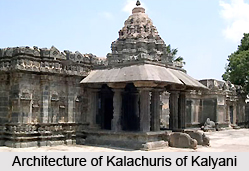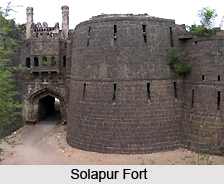 The history of Solapur district is one of dynastic rule. It has been ruled by many dynasties such as the Andhrabhratyas, the Chalukya dynasty, the Yadavas and the Bahamanis. The name Solapur is believed to be derived from two words `sola` meaning sixteen and `pur` meaning village. Present Solapur was considered to be spread over sixteen villages viz. Adilpur, Ahmedpur, Chapaldev, Fatehpur, Jamdarwadi, Kalajapur, Khadarpur, Khandervkiwadi, Muhammadpur, Ranapur, Sandalpur, Shaikpur, Solapur, Sonalagi, Sonapur and Vaidakwadi. However, recent research works points to an altogether different reason behind the name of Solapur district.
The history of Solapur district is one of dynastic rule. It has been ruled by many dynasties such as the Andhrabhratyas, the Chalukya dynasty, the Yadavas and the Bahamanis. The name Solapur is believed to be derived from two words `sola` meaning sixteen and `pur` meaning village. Present Solapur was considered to be spread over sixteen villages viz. Adilpur, Ahmedpur, Chapaldev, Fatehpur, Jamdarwadi, Kalajapur, Khadarpur, Khandervkiwadi, Muhammadpur, Ranapur, Sandalpur, Shaikpur, Solapur, Sonalagi, Sonapur and Vaidakwadi. However, recent research works points to an altogether different reason behind the name of Solapur district.
It is evident from the inscriptions of Shivayogi Shri.Siddheshwar of the time of the Kalachuris of Kalyani, that the town was called `Sonnalage` which came to be pronounced as `Sonnalagi`. The town was known as Sonnalagi even until the times of the Yadavas. A sanskrit inscription found at Kamati in Mohol and dated 1238, after the downfall of the Yadavas, shows that the town was known as Sonalipur. One of the inscriptions found in Solapur fort shows that the town was called Sonalpur while another inscription on the well in the fort shows that it was known as Sandalpur. During the Muslim period, the town was known as Sandalpur. It is therefore most probably that that during the course of time the name Solapur was evolved by dropping `na` from the name Sonalpur. Subsequently the British rulers pronounced Solapur as Sholapur and hence the name of the district.
The importance of Solapur is unique in the history of India in the sense that this district enjoyed freedom even before independence. The citizens of Solapur enjoyed the Independence for three days from 9th to 11th May 1930. The brief history runs like this. After the arrest of Mahatma Gandhi in May 1930, protests and demonstrations against the British Rule were held throughout India. Large scale rallies and protests were done at Solapur also. Many citizens lost their lives in the police firings. Due to this the irate mob attacked the Police Stations. Out of fear the police and other officers ran out of Solapur. During this period the responsibility of law, order and security of citizens was on the shoulders of congress party leaders. Then city congress President Shri Ramkrishna Jaju, with his other congressmen maintained the law and order for a period of three days from 9th to 11th May 1930.
Secondly, the Solapur Municipal Council was the first Municipal Council of India to host the National Flag on the Municipal Council building (Now Municipal Corporation) Solapur in 1930. Taking the spirit of Dandi March from Mahatma Gandhi, the freedom fighters of Solapur decided to host the National Flag on the Solapur Municipal Council. Accordingly, a senior freedom fighter from Pune Shri.Annasaheb Bhopatkar hosted the National Flag on 6th April 1930 on Municipal Council. This was the first and most unique incidence of its kind throughout the country. The British rulers declared Marshall Law at Solapur and arrested many leaders and innocent citizens on false charges. The freedom fighters Shri.Mallappa Dhanshetti, Shri.Kurban Hussain, Shri.Jagnnath Shinde and Shri.Kisan Sarda were arrested on charges of killing two Policemen of Mangalwar Police Station. The lower court sentenced the punishment of hanging till death for these freedom fighters. The High Court also confirmed the same decision and these four freedom fighters were hanged till death on 12th January 1931. As a mark of respect to these freedom fighters, the Statues of these freedom fighters have been installed in the heart of the city and the location has been named as Hutatma Chowk.
The present Solapur district was previously part of Ahmednagar, Pune and Satara districts. In 1838 it became the Sub-district of Ahmednagar. It included Barshi, Mohol, Madha, Karmala, Indi, Hippargi and Muddebihal Sub-divisions. In 1864 this Sub-district was abolished. In 1871 this district was reformed joining the Sub-divisions viz. Solapur, Barshi, Mohol, Madha and Karmala and two Subdivisions of Satara district viz. Pandharpur, Sangola and in 1875 Malshiras Sub-division was also attached. After the State reorganisation in 1956 Solapur was included in Mumbai State and it became a full- fledged district of the state of Maharashtra in 1960.






